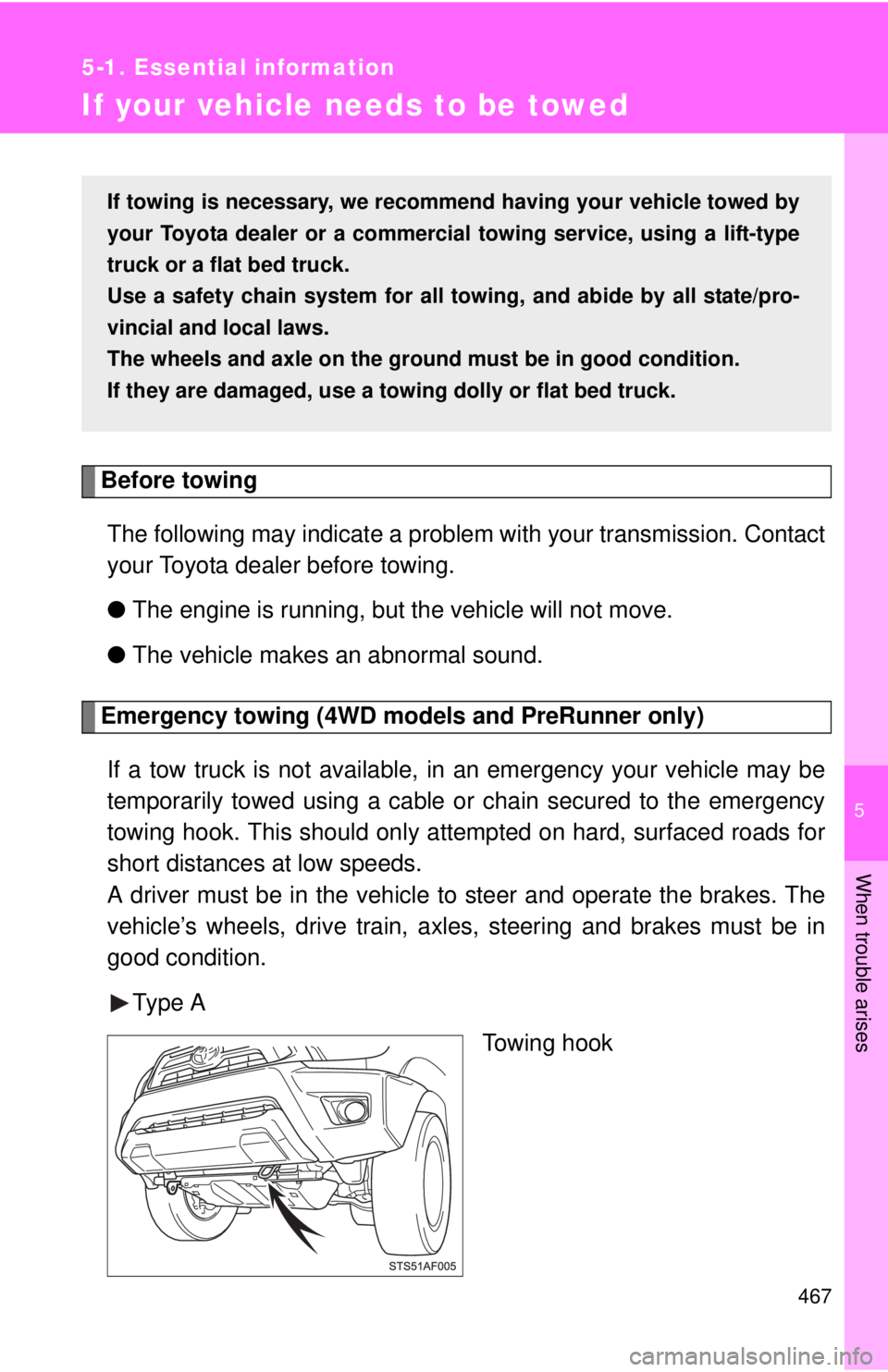Page 165 of 590
165
2-4. Using other
driving systems
2
When driving
CAUTION
■To avoid operating the cruise control by mistake
Switch the cruise control off using the ON-OFF button when not in use.
■ Situations unsuitable for cruise control
Do not use cruise control in any of the following situations.
Doing so may result in loss of control and could cause an accident resulting
in death or serious injury.
●In heavy traffic
● On roads with sharp bends
● On winding roads
● On slippery roads, such as those covered with rain, ice or snow
● On steep hills
Vehicle speed may exceed the set speed when driving down a steep hill.
● When your vehicle is towing a trailer or during emergency towing
Page 448 of 590

448 4-3. Do-it-yourself maintenance
FuseAmpereCircuit
1 A/C 10 A Air conditioning system
2 TOWING TAIL 30 A Trailer lights (tail lights)
3 FOG FR 15 A Front fog lights
4 STOP 10 A Stop lights, high mounted stop-
light, vehicle stability control sys-
tem, anti-lock brake system, shift
lock system, multiport fuel injection
system/sequential multiport fuel
injection system, towing lights
5 TOWING BRK 30 A Trailer brake controller
6 EFI 10 A Multiport fuel injection system/
sequential multiport fuel injection
system
7 S/HTR NO.2 30 A Seat heaters
8 OBD 7.5 A On-board diagnosis system
9 BATT CHG 30 A Trailer sub battery
10 AIR PMP HTR 10 A AI system
11 TOWING 30 A Towing lights
12 TURN & HAZ 15 A Turn signal lights, emergency
flashers, meter and gauge
13 RADIO NO.2 30 A Audio system
14 H-LP RH-LO 10 A Right-hand headlight (low beam),
front fog lights
15 H-LP LH-LO 10 A Left-hand headlight (low beam)
16 H-LP RH-HI 10 A Right-hand headlight (high beam)
17 H-LP LH-HI 10 A Left-hand headlight (high beam),
meter and gauge
18 ETCS 10 A Multiport fuel injection system/
sequential multiport fuel injection
system, electronic throttle control
system
Page 467 of 590

5
When trouble arises
467
5-1. Essential information
If your vehicle needs to be towed
Before towingThe following may indicate a problem with your transmission. Contact
your Toyota dealer before towing.
● The engine is running, but the vehicle will not move.
● The vehicle makes an abnormal sound.
Emergency towing (4WD models and PreRunner only)
If a tow truck is not available, in an emergency your vehicle may be
temporarily towed using a cable or chain secured to the emergency
towing hook. This should only attempted on hard, surfaced roads for
short distances at low speeds.
A driver must be in the vehicle to steer and operate the brakes. The
vehicle’s wheels, drive train, axles, steering and brakes must be in
good condition.
Type A Towing hook
If towing is necessary, we recommend having your vehicle towed by
your Toyota dealer or a commerci al towing service, using a lift-type
truck or a flat bed truck.
Use a safety chain system for all to wing, and abide by all state/pro-
vincial and local laws.
The wheels and axle on the groun d must be in good condition.
If they are damaged, use a towing dolly or flat bed truck.
Page 468 of 590
468 5-1. Essential information
Type BTowing hook
■Emergency towin g procedure
The engine switch must be in the ACC (engine off) or the ON
(engine running) position.
4WD models: Put the front-wheel drive control switch in H2.
Put the shift lever in N.
Release the parking brake.
CAUTION
■ Caution while towing
●Use extreme caution when towing the vehicle.
Avoid sudden starts or erratic driving maneuvers which place excessive
stress on the emergency towing hook and the cables or chains. Always be
cautious of the surroundings and other vehicles while towing.
● If the engine is not running, the power assist for the brakes and steering
will not function, making steering and braking more difficult.
Page 469 of 590
5
When trouble arises
469
5-1. Essential information
Towing with a sling-type truck
NOTICE
■
Emergency towing hook precautions
●Before emergency towing, check that the hook is not broken or damaged.
● Fasten the towing cable or chain securely to the hook.
● Do not jerk the hook. Apply steady and even force.
● To avoid damaging the hook, do not pull from the side or at a vertical
angle. Always pull straight ahead.
NOTICE
■To prevent body damage
Do not tow with a sling-type truck, either from the front or rear.
Page 495 of 590
5
When trouble arises
495
5-2. Steps to take in an emergency
Firmly tighten each nut two or three times in the order shown
in the illustration.
Tightening torque:
83 ft·lbf (113 N·m, 11.5 kgf·m)
2WD models except PreRunner
4WD models and PreRunner
Stowing the flat tire, jack and all tools
Lay down the tire with the outer
side facing up, and install the
holding bracket.
Page 500 of 590

500 5-2. Steps to take in an emergency
NOTICE
■Do not drive the vehicle with a flat tire
Do not continue driving with a flat tire.
Driving even a short distance with a flat tire can damage the tire and the
wheel beyond repair.
■When stowing the flat tire
Ensure that there is no object caught between the tire and the vehicle
underbody.
■When replacing the tires
●When removing or fitting the wheels, tires or the tire pressure warning
valve and transmitter, contact your Toyota dealer as the tire pressure
warning valve and transmitter may be damaged if not handled cor-
rectly.
●Replace the grommets for the tire pressure warning valves and trans-
mitters as well.
■To avoid damage to the tire pressure warning valves and transmit-
ters
When a tire is repaired with liquid sealants, the tire pressure warning
valve and transmitter may not operate properly. If a liquid sealant is
used, contact your Toyota dealer or other qualified service shop as soon
as possible. Make sure to replace the tire pressure warning valve and
transmitter when replacing the tire. ( P. 423)
Page 512 of 590
512 5-2. Steps to take in an emergency
NOTICE
■To avoid damaging the transmission and other components
●Avoid spinning the wheels and do not rev up the engine.
● If the vehicle remains stuck after trying these procedures, the vehicle may
require towing to be freed.